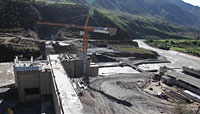China is world-famous for the Great Wall, a mega-project that never actually worked for its intended purpose (to keep pesky invaders like the Mongols out).
Lesser-known fact: China is today building great walls of concrete all over the world. The Three Gorges Dam on the Yangtse is the largest concrete object on earth. China is far and away the world's largest exporter of dam technology, providing a packaging of engineering and long-term financing for building mega-dams in third-world countries. Currently, Chinese engineers are supervising construction of over 300 dams in 74 countries, particularly in Africa and Southeast Asia. A number of these are highly controversial. Local indigenous groups—the ones most impacted by large dam building—are rarely consulted about these projects. The Chinese engineering style is to sneak in and proceed with rapid construction—before objections can be raised.
In 2007, at the United Nations, China voted in favour of the UN Declaration on the Rights of Indigenous Peoples. This document stipulates that indigenous peoples have the right of consent regarding “any project affecting their lands.” But from Tibet to the Sudan, this principle has been flagrantly violated by Chinese commercial interests, particularly Chinese dam-building consortiums.
As well as extensively damming Tibet's rivers, China is building large dams downstream on the same rivers—in the nations of Pakistan, Nepal, Burma, Laos and Cambodia. In several cases—Burma and Laos particularly—the intent is to export the hydro generated back to China, in a form of dam colonialism.
For more on China's global dam-building ambitions, you can download a booklet from from International Rivers, titled New Great Walls: a guide to China's overseas dam industry.
CHINA'S WORLDWIDE DAM CONSTRUCTION AND HUMAN RIGHTS ISSUES
—the following piece is written by Dr Ngo The Vinh, a Vietnamese researcher who is deeply concerned about the effects of China's damming on the Mekong and its impact on Vietnam...
Approximately half of the world's dams are found in China. Beijing also owns the biggest dam building companies on the globe.
Only a few decades ago, China still had to rely on the dam building companies in the West like the multinational conglomerate Ertan Hydroelectric Development Corporation (EHDC) for technological assistance in the implementation of the Three Gorges Dam projects. However, the Chinese meantime had in the ready a strategy to deal with foreign companies. They required those who do business with them to manufacture half of the turbines and electric generators in China with the participation of local hydroelectric engineers and technical workers. This is a cost-effective way of achieving technological transfer from the West to China in a very short time.
Lured by billions of dollars in profit, the big companies of the West like ABB, Alstom, General Electric, and Siemens agreed to those terms and by the same token facilitated the transfer of industrial production process to China. The young Chinese engineers did not let that opportunity slip through their fingers. They learned fast and mastered the science of dam building from their foreign colleagues. It did not take them long to design and manufacture all the machinery and equipments needed for the construction of dams in Mainland China.
The end result: China, nowadays, has surpassed its teachers, controlled the market of dam construction and is now in charge of 19 of the 24 largest dam building projects in the world. There are no known statistics to verify it but it is safe to assume that not a few turbines and equipments in the big and small dams of Vietnam bear the stamp “made in China”.
Besides the fact that China has mastered the technology for dam building, many have wondered how she was able to “export the industry of dam building” to so many countries in such a short time?
Mr. Peter Bosshard, Policy Director of the International River Network (IRN), believes he has found the answer to that question. In his opinion, Western companies may command more experience and higher technology but, as a group, they are at the same time more mindful of the social and environmental impacts caused by the dams they build. On account of this “respect for human rights”, they tend to be “cautious and conservative” in their business dealings. On the other hand, China failed to show the same degree of concern to those issues. Beijing had never let go of an opportunity to make a profit. It did not have second thoughts when submitting a bid and proceeded on regardless of whether it met the ecological criteria set by the international community or not.
In the end, before the court of public opinion, China cannot claim total innocence for the disastrous impacts caused by the dams it has invested in and built. A good example of it are the ecological mishaps that are unfolding in the Greater Mekong Subregion (GMS). To describe this situation, the press has cleverly offered a picture of a China that walks on thin ice. Such an image of China will undoubtedly worsen were that country to persist in carrying out their objectionable building projects all over this planet.
It is this author's hope that the countries involved will succeed to work out an equitable arrangement for their worsening water shortage to spare a large portion of the world's population from much suffering and miseries. A “war for water” that a number of observers foresee will not be in the interest of humankind and should be avoided at any costs.
—Ngo The Vinh, California July 20, 2010
Source: Viet Ecology Foundation
